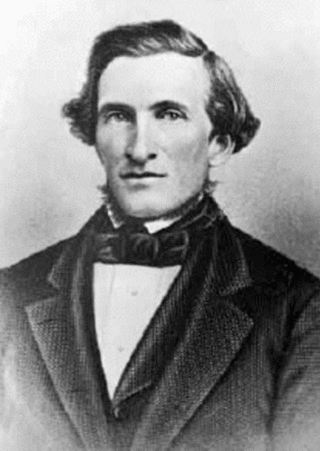
Fillmore is a city and the county seat of Millard County, Utah, United States. The population was 2,592 at the 2020 United States Census. It is named for the thirteenth U.S. President Millard Fillmore, who was in office when Millard County was created by the Utah Territorial legislature.

The State of Deseret was a proposed state of the United States, promoted by leaders of the Church of Jesus Christ of Latter-day Saints who had founded settlements in what is today the state of Utah. A provisional state government operated for nearly two years in 1849–50, but was never recognized by the United States government. The name Deseret derives from the word for "honeybee" in the Book of Mormon.

Jedediah Morgan Grant was a leader and an apostle of the Church of Jesus Christ of Latter-day Saints. He was member of the First Council of the Seventy from 1845 to 1854 and served in the First Presidency under church president Brigham Young from 1854 to 1856. He is known for his fiery speeches during the Reformation of 1856, earning the nickname "Brigham's Sledgehammer". Grant is the father of Heber J. Grant, who later served as President of the Church.

The Utah Territorial Statehouse, officially Territorial Statehouse State Park Museum, is a state park in Fillmore, Utah. The museum and park preserves the original seat of government for Utah Territory before the capital was moved to Salt Lake City in 1856. Built from 1852 to 1855, the statehouse was initially intended as a larger structure, but only the south wing was completed before the project was abandoned due to lack of federal funding. After its construction, the Utah Territorial Legislative Assembly met in the building for only one full session and parts of two others.

The Utah State Legislature is the state legislature of the U.S. state of Utah. It is a bicameral body, comprising the Utah House of Representatives, with 75 state representatives, and the Utah Senate, with 29 state senators. There are no term limits for either chamber.
The 2nd Utah Territorial Legislature comprised members of the Territorial Council serving the second year of their terms, together with members of the House of Representatives elected to one-year terms. The regular election was held August 2, 1852. Due to multiple resignations in both chambers, a special election to fill the vacancies was held November 8, 1852. Members of the Territorial Council from the 1st Utah Territorial Legislature who resigned prior to the session included Orson Pratt, Orson Spencer, and John S. Fullmer.

John Riggs Murdock was a Mormon pioneer, Utah politician, and leader of the Church of Jesus Christ of Latter-day Saints in Beaver, Utah. He is sometimes credited as the leader of the most down-and-back companies in Latter-day Saint history, as he directed multiple ox-drawn wagon trains sent from Utah to bring back both merchandise and emigrating church members from back East. Murdock also served several missions in the eastern United States.

Oregon's Territorial Legislature was a bicameral legislative body created by the United States Congress in 1848 as the legislative branch of the government of the Oregon Territory. The upper chamber Council and lower chamber House of Representatives first met in July 1849; they served as the region's legislative body until Oregon became a state in February 1859, when they were replaced by the bicameral Oregon State Legislature.

The Legislature of the Hawaiian Kingdom was the bicameral legislature of the Hawaiian Kingdom. A royal legislature was first provided by the 1840 Constitution and the 1852 Constitution was the first to use the term Legislature of the Hawaiian Islands, and the first to subject the monarch to certain democratic principles. Prior to this the monarchs ruled under a Council of Chiefs.

Daniel Spencer was the last mayor of Nauvoo, Illinois prior to the revocation of its first charter.

Chauncey Walker West was a Mormon pioneer and was a leader of the Church of Jesus Christ of Latter-day Saints in Utah Territory. He was among the church's first missionaries to preach in Sri Lanka.

Malad County, Utah Territory was created 12 January 1856 from part of Weber County. The Utah legislature discontinued Malad County on January 17, 1862, and its land was given to Box Elder County. Malad County is now extinct.
The 4th Utah Territorial Legislature comprised members of the Territorial Council serving the second year of their terms, together with members of the House of Representatives elected to one-year terms. The regular election for the House was held August 7, 1854. Several vacancies in Territorial Council were also filled at that time due to the death of Willard Richards and the resignations of Parley P. Pratt and John Taylor.
The 5th Utah Territorial Legislature was elected on August 6, 1855.
The 6th Utah Territorial Legislature comprised members of the Territorial Council serving the second year of their terms, together with members of the House of Representatives elected to one-year terms. The regular election for the House was held August 4, 1856.
The 7th Utah Territorial Legislature was elected on August 3, 1857.
The 8th Utah Territorial Legislature comprised members of the Territorial Council serving the second year of their terms, together with members of the House of Representatives elected to one-year terms.
The 9th Utah Territorial Legislature was elected on August 1, 1859.
The 11th Utah Territorial Legislature was elected on August 5, 1861.










